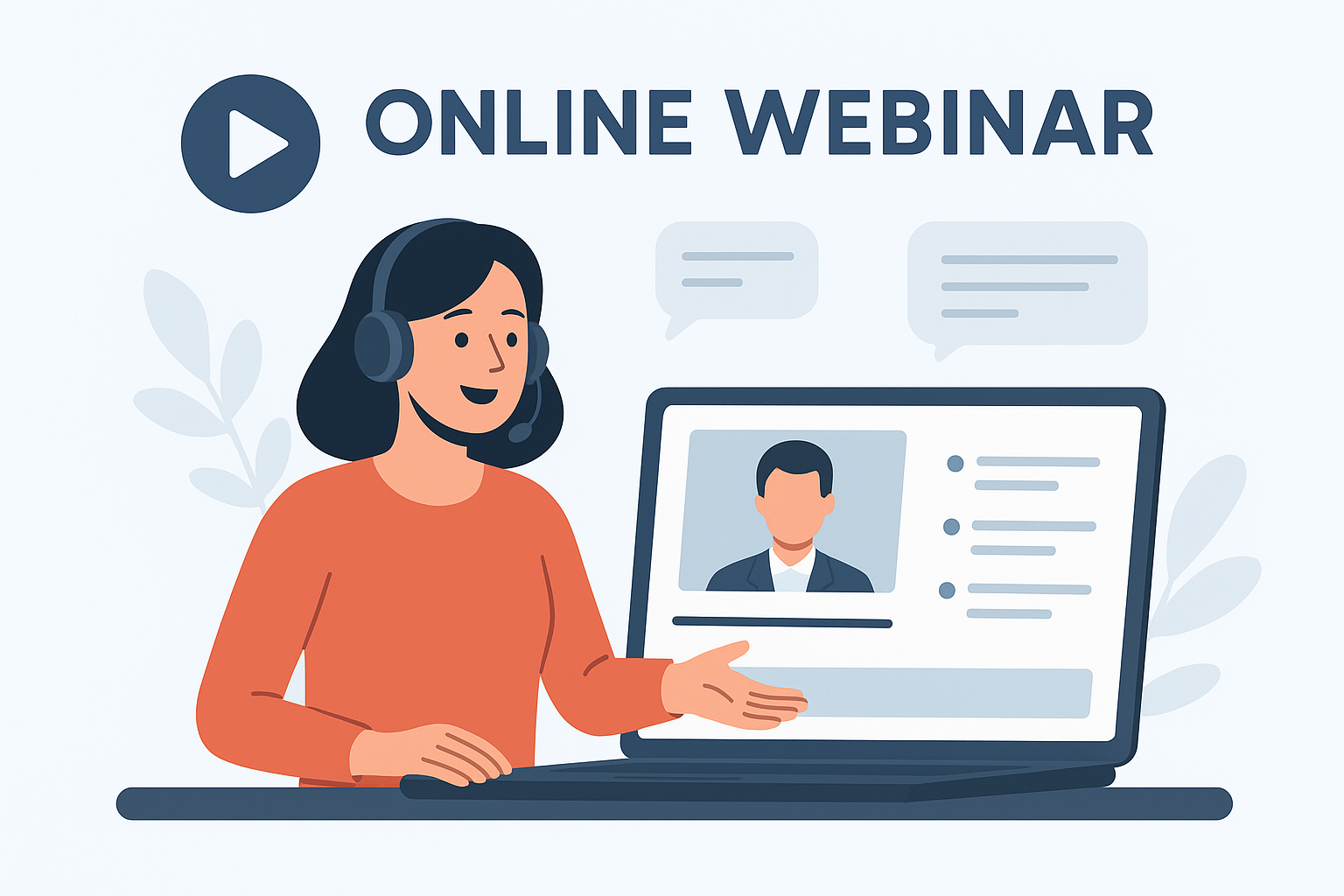What is an Online Webinar? – An online webinar is a live or recorded event held over the internet where a host shares information with an audience in real-time. It allows people to connect, learn, and interact without being in the same physical location. Webinars can include presentations, discussions, product demonstrations, or training sessions. All you need is a device with an internet connection, and you can join from anywhere in the world.
Why Are Webinars Popular for Businesses, Educators, and Influencers?
Webinars have become one of the most powerful tools for communication and engagement. Businesses use them to showcase products and build brand trust. Educators rely on webinars to teach and share knowledge with students across different locations. Influencers and industry experts host webinars to grow their audience and create meaningful connections. They are easy to set up, cost-effective, and can reach thousands of people in just a few clicks.
The Benefits of Hosting a Webinar (Engagement, Branding, Sales, Education)
Hosting a webinar comes with many advantages. It helps businesses engage with potential customers in a more personal way. Webinars also boost brand awareness because they position the host as an expert in their field. For marketers, webinars are great for generating leads and increasing sales. In the education sector, webinars make learning flexible and accessible. Overall, they provide value for both the host and the audience, making them one of the most effective tools for online communication.
Read More:How to Save Money By Lowering Your Car Insurance Premium
Why Organize an Online Webinar?
Cost-Effectiveness Compared to Physical Events
One of the biggest reasons people choose webinars is the cost advantage. Hosting a physical event requires a venue, travel expenses, printed materials, and catering. These costs add up quickly, especially for large gatherings. An online webinar removes most of these expenses. You don’t need to rent a hall or pay for logistics. With just a computer, a stable internet connection, and a good platform, you can organize a professional event at a fraction of the cost. This makes webinars the perfect choice for businesses, coaches, and educators looking to save money while still delivering high-quality content.
Global Reach and Accessibility
Webinars break the barriers of location. Unlike physical events where attendees need to travel, an online webinar allows people from anywhere in the world to join. This global reach opens up new opportunities for businesses and educators to connect with a wider audience. All participants need is an internet connection and a device. This convenience makes webinars more attractive because they save time and effort for both the host and the audience. Plus, people with disabilities or those living in remote areas can still take part, making webinars an inclusive and accessible option.
Read Also:What It Is Insurance – How It Works, Types, Pros & Cons
Opportunities for Lead Generation and Networking
Webinars are not just about sharing information they are powerful marketing tools. When people register for a webinar, they provide their contact details, which businesses can use to build an email list. During the webinar, hosts can interact with attendees, answer questions, and showcase their expertise. This interaction builds trust and positions the host as a reliable authority in their industry. After the webinar, these connections often turn into sales, partnerships, or loyal followers. For professionals and influencers, webinars create a great platform for networking and forming long-term relationships.
Planning Your Webinar
Define Your Objective
Every successful webinar begins with a clear purpose. Before setting a date or creating slides, you need to know why you are hosting the webinar. Is it to create brand awareness, educate your audience, demonstrate a product, or generate leads? Your objective will guide everything—from the topic you choose to the way you promote the event. For example, if your goal is lead generation, you’ll focus on content that solves a specific problem for your target audience and include a call-to-action. If your aim is education, your webinar should be structured like a lesson, offering in-depth knowledge and practical tips. A clear objective keeps your planning focused and ensures your efforts deliver results.
Don’t Forget: How to Start Investing with Little Money: Smart Strategies to Grow Your Wealth in 2025
Identify Your Target Audience
Knowing who you want to reach is just as important as knowing what you want to achieve. Your target audience determines the tone, language, and depth of your content. Are you speaking to business professionals, students, or everyday consumers? Understanding your audience helps you create content that speaks directly to their needs and interests. It also affects when you schedule the webinar and how you promote it. For instance, if your audience is in multiple countries, you need to pick a time that works for most time zones. When you plan with your audience in mind, you increase the chances of engagement and attendance.
Choose the Right Topic
The topic of your webinar is what attracts people to sign up, so it needs to be relevant and valuable. A great topic solves a problem or answers a question your audience cares about. It should be specific enough to grab attention but broad enough to allow meaningful discussion. For example, “How to Boost Sales in 30 Days with Social Media” is more appealing than “Marketing Tips.” When choosing a topic, consider trending issues in your industry, questions your customers frequently ask, and areas where you can provide expert advice. A well-chosen topic ensures your webinar stands out and delivers real value to participants.
Selecting the Right Webinar Platform
Popular Platforms (Zoom, Microsoft Teams, Google Meet, WebinarJam)
Choosing the right platform is one of the most important steps in hosting a successful webinar. There are many platforms available, and each one comes with unique features. Zoom is one of the most popular because of its user-friendly interface and strong engagement tools. Microsoft Teams is great for corporate webinars, especially for organizations that already use Office 365. Google Meet is a simple and free option for smaller webinars or internal meetings. WebinarJam is designed specifically for webinars and offers advanced tools like automated replays and built-in marketing features. The best platform for you depends on your goals, audience size, and budget.
Key Features to Look For (Screen Sharing, Q&A, Recording, Analytics)
Not all webinar platforms are the same, so it’s important to choose one that offers the features you need. Screen sharing is essential if you plan to give presentations or demonstrate a product. A Q&A feature allows attendees to ask questions, making the session interactive. Recording options are a must-have because they allow you to share the webinar with people who couldn’t attend live or repurpose the content later. Analytics tools are also valuable because they help you track attendance, engagement, and performance. These features make your webinar more professional and provide data to improve future sessions.
Pricing Considerations and Free Options
Webinar platforms come with different pricing plans, so it’s important to choose one that fits your budget. Free options like Google Meet or Zoom’s basic plan are good for small groups and short sessions. However, if you want advanced features such as custom branding, automated follow-ups, or detailed analytics, you might need a paid plan. Some platforms offer monthly or yearly subscriptions, while others charge per event. When making your choice, consider both the features you need and the size of your audience. Paying for the right tools can make your webinar more effective and professional.
Scheduling Your Webinar
Choosing the Right Date and Time for Maximum Attendance
Picking the perfect date and time for your webinar can make a big difference in attendance. Weekdays often work best, especially mid-week—Tuesday, Wednesday, or Thursday—because people are less likely to be busy with weekend plans or Monday catch-up work. When selecting a time, think about when your audience is most active. For business professionals, late mornings or early afternoons are ideal. If your audience includes students or freelancers, evenings might work better. Avoid public holidays or major events that could distract people from attending.
Considering Time Zones for Global Audiences
If you are hosting an international webinar, time zones are a critical factor. A time that works for you might not work for attendees on the other side of the world. Use tools like World Time Buddy to find overlapping time slots that are convenient for most participants. Another option is to host two sessions at different times to accommodate multiple regions. Alternatively, record the webinar and share the replay for those who can’t attend live. Being mindful of time zones shows you value your audience, which helps increase attendance and engagement.
Sending Calendar Invites and Reminders
Even if people register for your webinar, they can easily forget about it. That’s why reminders are important. Send a confirmation email immediately after registration, followed by reminder emails a few days before and on the day of the event. Include the webinar date, time, and the link to join. Calendar invites are also helpful because they allow participants to add the event to their schedule with one click. Some webinar platforms offer automated reminders, which makes this process easier and ensures nobody misses out.
Creating Engaging Content for Your Webinar
Presentation Design Tips (Slides, Visuals, Flow)
Your presentation is the backbone of your webinar, so make it visually appealing and easy to follow. Use clean, professional slides with minimal text. Instead of paragraphs, use bullet points and visuals like images or graphs. Choose colors that match your brand and fonts that are easy to read. Keep each slide focused on one main idea to avoid overwhelming your audience. A smooth flow from one topic to another keeps participants engaged and helps them understand the message better.
Engagement Tools (Polls, Live Chat, Q&A)
A webinar should not feel like a lecture—it should be interactive. Most platforms provide engagement tools like polls, quizzes, and live chat. Use polls to get instant feedback or test participants’ knowledge during the session. Encourage attendees to ask questions through the Q&A feature. A live chat option allows participants to share thoughts and interact with each other, creating a community feel. These interactive elements keep the audience involved and make your webinar more memorable.
Storytelling and Value Delivery
People remember stories more than plain facts. Incorporating storytelling into your webinar makes the content relatable and engaging. Share real-life examples, case studies, or personal experiences that connect with your audience. At the same time, focus on delivering value—give actionable tips, useful resources, or insights that participants can apply immediately. When people feel they are learning something meaningful, they are more likely to stay until the end and attend future webinars.
Promoting Your Webinar
Email Marketing Strategies
Email remains one of the most effective ways to promote your webinar. Start by creating an email list of potential attendees, including your customers, subscribers, and business contacts. Send an announcement email as soon as the webinar is scheduled, highlighting the topic, date, and what attendees will gain. Make the subject line catchy so people open the email. Include a clear call-to-action button for registration. After the initial invite, send follow-up emails to remind people and encourage them to sign up. Personalized emails with the recipient’s name and relevant details can boost engagement and increase registration rates.
Social Media Campaigns (Facebook, LinkedIn, Instagram, Twitter)
Social media platforms are powerful tools for spreading the word about your webinar. Create eye-catching posts that include the webinar topic, date, time, and a link to register. On Facebook, you can create an event page and invite followers to join. LinkedIn is great for professional webinars, share posts in relevant groups and engage with your connections. Use Instagram Stories and Reels to create short, engaging video teasers. Twitter can be used for quick updates and reminders. Don’t forget to use relevant hashtags to increase visibility and reach more people.
Using Paid Ads and Influencer Marketing
If you want to reach a larger audience quickly, consider using paid ads on social media platforms like Facebook and Instagram. These ads allow you to target specific audiences based on location, interests, and demographics. Influencer marketing is another effective strategy—partner with influencers in your niche to promote your webinar to their followers. Influencers can create authentic content, such as a short video or a post, encouraging people to register. Both strategies work well if your goal is to boost attendance and generate leads.
Creating a Registration Landing Page
A dedicated landing page for your webinar makes registration simple and professional. The page should clearly state the topic, date, time, and what participants will learn. Include a strong headline, a short description of the benefits, and a simple sign-up form. Adding testimonials or past webinar highlights can build trust and encourage more people to register. Make sure the page is mobile-friendly and loads quickly since many users access it from their phones. A well-designed landing page increases conversions and ensures a smooth registration process.
Technical Setup and Testing
Internet Speed and Backup Plan
A strong internet connection is essential for a smooth webinar. Slow or unstable internet can lead to buffering, poor audio, and dropped connections, which frustrate attendees. Before the event, test your internet speed to make sure it meets the platform’s requirements. If possible, use a wired connection instead of Wi-Fi for better stability. Always have a backup plan, such as a secondary internet source like a mobile hotspot, in case your main connection fails. This ensures your webinar runs without major interruptions.
Audio and Video Equipment Setup
Clear audio and sharp video are critical for keeping participants engaged. Use a good-quality microphone instead of relying on your computer’s built-in mic. For video, a high-definition webcam with proper lighting makes a big difference. Avoid sitting with your back to a window to prevent shadows. Instead, use natural light or a ring light in front of you for a bright, professional look. Test your audio and video settings on the webinar platform before the event to ensure everything works properly.
Dry Runs and Technical Rehearsals
Never skip a practice session before going live. A dry run allows you to check your slides, test the screen-sharing feature, and make sure all engagement tools like polls and Q&A work as expected. If you have guest speakers, include them in the rehearsal so everyone knows the flow and timing. During the test run, practice switching between screens, handling chat questions, and managing technical features. This preparation reduces the chance of errors during the actual webinar and helps you feel more confident.
Hosting the Webinar
How to Open and Keep Attendees Engaged
The first few minutes of your webinar are crucial for making a strong impression. Start by introducing yourself, stating the purpose of the session, and giving a quick overview of what participants will learn. Keep your energy high and your tone friendly to grab attention right away. Use visuals, stories, and interactive tools like polls to maintain interest throughout the session. Break up the content into short sections so the audience doesn’t feel overwhelmed. Engagement is the key to keeping participants until the end.
Moderating Questions and Discussions
Encouraging audience interaction makes a webinar more engaging and valuable. Allocate time for questions at the end or throughout the session, depending on your format. Use the Q&A feature or chat box to collect questions, and answer them clearly. If you have a moderator or co-host, let them manage the chat so you can focus on presenting. This interaction builds trust and makes participants feel included, which increases satisfaction and the chances they’ll attend future webinars.
Handling Unexpected Issues (Tech Glitches, Low Attendance)
Even with the best planning, unexpected problems can happen. A common issue is technical glitches, like audio dropping or slides not loading. Stay calm and have backup options, such as switching to another device or restarting the platform if necessary. Low attendance can also happen, especially for the first few webinars. Instead of getting discouraged, focus on delivering value to those who showed up and use the recording for future promotions. Handling challenges professionally shows your audience that you are prepared and reliable.
Post-Webinar Follow-Up
Sending Thank-You Emails
Following up after the webinar is just as important as the event itself. Start by sending thank-you emails to everyone who attended. This simple gesture shows appreciation and strengthens your relationship with participants. In the email, include a personalized thank-you message, a summary of the key points discussed, and any promised resources. If you had a call-to-action during the webinar, such as signing up for a service or joining a program, this is a great place to include it again. Thank-you emails help keep your audience engaged and open the door for future interactions.
Sharing the Webinar Recording and Resources
Not everyone who registered will attend the live session, which is why sharing the recording is essential. Include the replay link in your follow-up email and make it easy to access. You can also provide additional resources such as presentation slides, downloadable guides, or links to related articles. Offering these materials adds value and ensures participants can revisit the information whenever they need it. This also helps you reach those who missed the event, extending the impact of your webinar.
Collecting Feedback and Surveys
Feedback is a valuable tool for improving your future webinars. After the event, send a short survey asking participants about their experience. Questions can include what they liked, what could be improved, and what topics they would like to see in the future. Keep the survey simple and quick to complete. You can also include a rating scale for ease of response. Gathering feedback helps you understand your audience better and create more effective, engaging webinars next time.
Repurposing Webinar Content (Blogs, Clips, Social Media Posts)
Your webinar content doesn’t have to end when the session is over. Repurpose it into other formats to reach a wider audience. For example, you can turn the webinar into a blog post, share short video clips on social media, or create an infographic summarizing the key points. These pieces of content can drive traffic to your website, attract new followers, and promote future webinars. Repurposing ensures you get maximum value from the time and effort invested in creating the webinar.
Measuring Success
Key Metrics to Track (Registrations vs Attendance, Engagement Rate, Conversions)
To know if your webinar was successful, you need to measure key performance indicators. Start by comparing the number of registrations to actual attendance. A big gap may indicate that reminders or timing need improvement. Engagement rate is another important metric, look at how many people participated in polls, asked questions, or stayed until the end. Finally, track conversions. Did your audience take the desired action, such as signing up for a service, downloading a resource, or making a purchase? These numbers help you understand the real impact of your webinar.
Using Analytics Tools from Your Webinar Platform
Most webinar platforms provide built-in analytics that make tracking easier. These tools can show detailed reports on attendance, engagement, and audience behavior during the session. For example, you can see how long participants stayed, which slides they interacted with, and how many questions were asked. Some platforms even provide heat maps or engagement scores, helping you identify what worked well and what needs improvement. Reviewing these reports is essential for making data-driven decisions for future events.
Improving Future Webinars Based on Data
Data is only useful if you apply it. Use the insights from your webinar analytics to refine your strategy. If attendance was low, you might need better promotion or a different time slot. If engagement dropped halfway, your content may need more interactive elements. Look at the questions participants asked to identify new topics for upcoming webinars. By continuously learning from your data, you can create webinars that are more engaging, more valuable, and more successful over time.
Common Mistakes to Avoid
Poor Promotion and Lack of Audience
A great webinar can fail if no one shows up. One of the most common mistakes is not promoting the event properly. Relying on a single post or one email is not enough to attract attendees. To avoid this, start your promotion early and use multiple channels such as email, social media, and paid ads if necessary. Keep reminding your audience with follow-up emails and countdown posts. Consistent promotion is the key to increasing attendance and ensuring your webinar reaches the right people.
Overloading Slides with Text
Slides that are packed with text can make your webinar boring and hard to follow. Many hosts make the mistake of putting their entire speech on the slides, which leads to information overload. Instead, use short bullet points, images, and graphics to make the presentation visually appealing. Speak through the details rather than reading them from the slides. A clean, simple design keeps your audience engaged and focused on what you are saying rather than trying to read long paragraphs on the screen.
Ignoring Technical Tests
Skipping a technical rehearsal is another major mistake. Many webinars face issues such as poor audio, frozen screens, or broken links simply because the host didn’t test everything beforehand. Always check your internet connection, microphone, camera, and webinar software before going live. If possible, run a full practice session with your co-host or guest speakers. Testing your setup ensures a smooth experience for your audience and prevents last-minute technical problems that could damage your credibility.
Conclusion
Organizing an online webinar may seem challenging at first, but with the right plan, it can be one of the most powerful ways to share knowledge, build your brand, and connect with a wider audience. We’ve covered every important step, from defining your objectives and choosing the right platform to promoting your webinar, engaging your audience, and following up after the event. Each of these steps plays a key role in making your webinar successful.
The good news is that you don’t need a huge budget or complicated tools to get started. With careful planning, a clear topic, and effective promotion, anyone can host a professional webinar that delivers real value. Start small, learn from your experience, and improve with every session.
Now is the perfect time to take action. Use this guide as your roadmap and begin organizing your first online webinar today. With the right approach, your webinar can attract a great audience, build trust, and create opportunities for growth. The world is ready to hear your message make your next move and start planning your successful webinar now!





